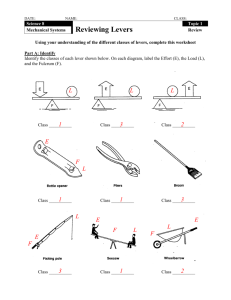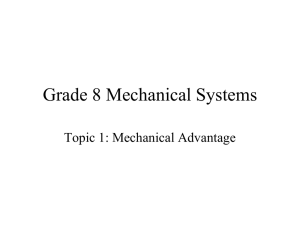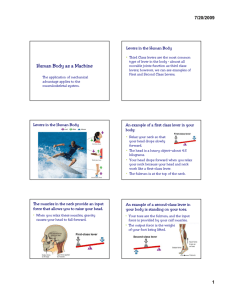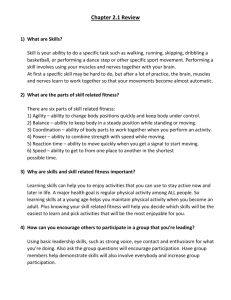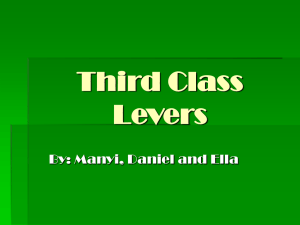Levers fill the gap
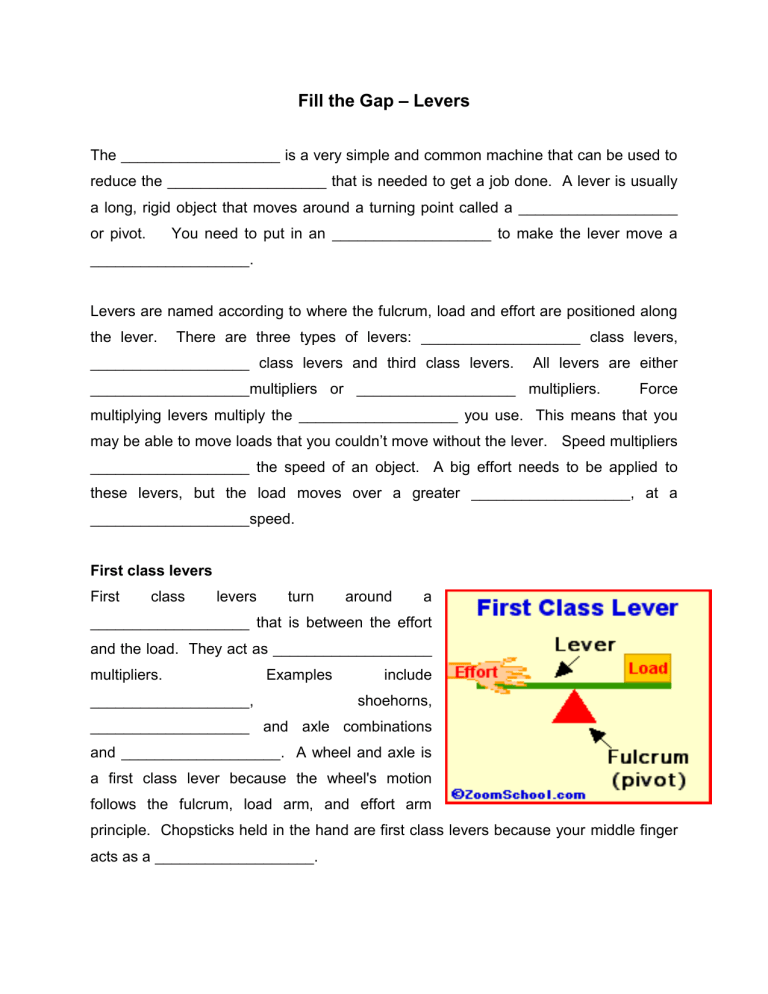
Fill the Gap – Levers
The ___________________ is a very simple and common machine that can be used to reduce the ___________________ that is needed to get a job done. A lever is usually a long, rigid object that moves around a turning point called a ___________________ or pivot. You need to put in an ___________________ to make the lever move a
___________________ .
Levers are named according to where the fulcrum, load and effort are positioned along the lever. There are three types of levers: ___________________ class levers,
___________________ class levers and third class levers. All levers are either
___________________ multipliers or ___________________ multipliers. Force multiplying levers multiply the ___________________ you use. This means that you may be able to move loads that you couldn’t move without the lever. Speed multipliers
___________________ the speed of an object. A big effort needs to be applied to these levers, but the load moves over a greater ___________________ , at a
___________________ speed.
First class levers
First class levers turn around a
___________________ that is between the effort and the load. They act as ___________________ multipliers.
___________________ ,
Examples include shoehorns,
___________________ and axle combinations and ___________________ . A wheel and axle is a first class lever because the wheel's motion follows the fulcrum, load arm, and effort arm principle. Chopsticks held in the hand are first class levers because your middle finger acts as a ___________________ .
First class levers act in your body when you
___________________ your head. The pivot in this case is the place where your skull meets the top of your
___________________ . Your skull is the
___________________ arm and the neck muscles at the back of the skull provide the force (effort) to lift your head up against the weight of the head (load). When the neck muscles relax, your head nods ___________________ .
Second class levers
Second class levers turn around a
___________________ that is at the end of the lever. The load is always between the
___________________ and the fulcrum. Second class levers act
___________________ multipliers.
Examples include
___________________ , bottle as openers, wheelbarrow and
___________________ .
___________________ class levers act in your body when you stand on tip toes. In this case, the
___________________ is at your toe joints and your foot acts as a ___________________ arm. Your calf muscles and Achilles ___________________ provide the effort when the calf muscle ___________________ . The load is your body weight and is lifted by the effort. The effort force needed is ___________________ than the load force, so there is a ___________________ advantage.
This muscular movement at the back of your legs allows you to move your whole body a small distance.
Third class levers
Third class levers are those in which the
___________________ is between the fulcrum and the load. They act as ___________________ multipliers. Examples include tongs,
___________________ racquets, hammers and spring-loaded ___________________ .
___________________ class levers act in your body when you bend your
___________________ . In this case the ___________________ or fulcrum is the elbow and the ___________________ acts as the lever arm. The ___________________ muscle provides the effort (force) and bends the forearm against the weight of the forearm and any weight that the hand might be holding.
There is no mechanical advantage because the effort is ___________________ than the load.
However this disadvantage is compensated with a ___________________ movement – a small contraction of the biceps produces a large movement of the forearm. This type of lever system also gives us the advantage of a much greater ___________________ of movement. Many muscle and bone combinations in our bodies are of the Class 3 lever type.
Mechanical advantage measures how much easier a lever makes a task.
Mechanical advantage =
___________________________
For a ___________________ class lever, placing the fulcrum ___________________ to the load means that less effort can be exerted to move a ___________________ load. This means the lever will have a
___________________ mechanical advantage.
Examples of levers in everyday life
On the gold fields, ___________________ used a wheel and axle to wind buckets of rock and soil to top of the mining shaft. The miner at the top turned the
___________________ (the wheel) and the rope wound around the axle, raising the bucket. This is an example of a ___________________ class lever. Another type of first class lever was the ___________________ . These were used to lift buckets of rock and soil to the top the mining shaft. The ___________________ the handle of the whip the easier it was to lift.
On building sites we also find different examples of levers in action. A
___________________ removing nail is a first class lever. The handles of a wheelbarrow are ___________________ class levers. ___________________ are simple wheel and axles (first-class lever).
At home in our kitchens we see levers in action. Using a ___________________ to open Milo can is using it as a ___________________ class lever. We also see
examples of wheel and axle combinations in ___________________ where they act as force multipliers and ceiling fans where they act as ___________________ multipliers.
Even the hinges on the kitchen cupboards are simple machines!!! They are examples of ___________________ class levers.
Simple machines are also seen in ___________________ . Tennis racquets, cricket bats and softball bats are all ___________________ class levers - they make objects move ___________________ and further. In diving the springboard acts as a
___________________ class lever. When rowing, the oar acts as a second class lever.
In this case, the water is the ___________________ ; the boat is the
___________________ and the ___________________ is at the inboard end of the oar.

